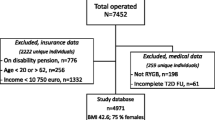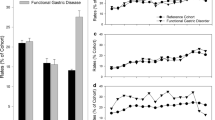Abstract
Background
Limited published data exist on the associated comorbid conditions with functional dyspepsia (FD).
Aims
This study aimed to assess the prevalence, services, and costs related to comorbid conditions associated with FD and the risk of having FD for each comorbid condition.
Methods
A retrospective database analysis was undertaken using payroll data and adjudicated claims from January 1, 2001, through December 31, 2004 among >300,000 employees. Employees with FD were compared to propensity-score-matched employees without FD (controls). Outcome measures included the prevalence, costs, and utilization of health services for comorbid conditions as defined by the Agency for Healthcare Research and Quality (AHRQ) and the odds ratios of having FD from a multivariate model.
Results
FD employees (N = 1,669) and a 50:1 matched control cohort (N = 83,450) were compared. Compared to matched controls, FD employees were more likely to have all major diagnostic categories. Moreover, 199/261 of the AHRQ’s specific categories were more common in the FD cohort. Annual medical costs for the FD cohort were greater than for controls in 155/261 (59%) specific categories and significantly greater (P ≤ 0.05) in 76 categories (29%). Similarly, services were greater for 179/261 (69%) specific categories and significantly greater (P ≤ 0.05) in 110 categories (42%). In a multivariate model, esophageal disorders, gastritis and duodenitis, and abdominal pain were the most associated with having FD (odds ratios 3.8, 3.7, and 3.6, respectively). Only hypertension complications and disorders of the teeth and jaw were significantly negatively associated with FD.
Conclusion
There is unexplained excess comorbidity associated with FD which may be a major determining factor for excess healthcare services and costs.
Similar content being viewed by others
Abbreviations
- FD:
-
Functional dyspepsia
- AHRQ:
-
Agency for Healthcare Research and Quality
- FGIDs:
-
Functional gastrointestinal disorders
- IBS:
-
Irritable bowel syndrome
- HCMS:
-
Human Capital Management Services
- ICD-9:
-
International Classification of Diseases, Ninth Revision
- MDCs:
-
Major diagnostic categories
- CPIs:
-
Consumer price indices
References
Tack J, Talley NJ, Camilleri M, et al. Functional gastroduodenal disorders. Gastroenterology. 2006;130:1466–1479.
Drossman DA, Li Z, Andruzzi E, et al. U.S. householder survey of functional gastrointestinal disorders. Prevalence, sociodemography, and health impact. Dig Dis Sci. 1993;38:1569–1580.
Jones R, Lydeard S. Prevalence of symptoms of dyspepsia in the community. BMJ. 1989;298:30–32.
Penston JG, Pounder RE. A survey of dyspepsia in Great Britain. Aliment Pharmacol Ther. 1996;10:83–89.
Talley NJ, Zinsmeister AR, Schleck CD, Melton LJ III. Dyspepsia and dyspepsia subgroups: a population-based study. Gastroenterology. 1992;102:1259–1268.
Camilleri M, Dubois D, Coulie B, et al. Prevalence and socioeconomic impact of upper gastrointestinal disorders in the United States: results of the US Upper Gastrointestinal Study. Clin Gastroenterol Hepatol. 2005;3:543–552.
Hsu PI, Lai KH, Tseng HH, et al. Eradication of Helicobacter pylori prevents ulcer development in patients with ulcer-like functional dyspepsia. Aliment Pharmacol Ther. 2001;15:195–201.
Wallander MA, Johansson S, Ruigomez A, Garcia Rodriguez LA, Jones R. Dyspepsia in general practice: incidence, risk factors, comorbidity and mortality. Fam Pract. 2007;24:403–411.
Whitehead WE, Palsson OS, Levy RR, Feld AD, Turner M, Von Korff M. Comorbidity in irritable bowel syndrome. Am J Gastroenterol. 2007;102:2767–2776.
Riedl A, Schmidtmann M, Stengel A, et al. Somatic comorbidities of irritable bowel syndrome: a systematic analysis. J Psychosom Res. 2008;64:573–582.
Frankhuisen R, Van Herwaarden MA, Heijkoop R, et al. Functional dyspepsia and irritable bowel syndrome in patients with achalasia and its association with non-cardiac chest pain and a decreased health-related quality of life. Scand J Gastroenterol. 2009;44:687–691.
Choung RS, Locke GR, Schleck CD, Zinsmeister AR, Talley NJ. Do distinct dyspepsia subgroups exist in the community? A population-based study. Am J Gastroenterol. 2007;102:1983–1989.
Talley NJ, Piper DW. The association between non-ulcer dyspepsia and other gastrointestinal disorders. Scand J Gastroenterol. 1985;20:896–900.
Choung RS, Locke GR 3rd, Zinsmeister AR, Schleck CD, Talley NJ. Psychosocial distress and somatic symptoms in community subjects with irritable bowel syndrome: a psychological component is the rule. Am J Gastroenterol. 2009;104:1772–1779.
Ford AC, Forman D, Bailey AG, Cook MB, Axon AT, Moayyedi P. Who consults with dyspepsia? Results from a longitudinal 10-yr follow-up study. Am J Gastroenterol. 2007;102:957–965.
Brook RA, Kleinman NL, Choung RS, Melkonian AK, Smeeding JE, Talley NJ. Functional dyspepsia impacts absenteeism and direct and indirect costs. Clin Gastroenterol Hepatol. 2008;8:498–503.
Rajagopalan K, Kleinman NL, Brook RA, Gardner HH, Brizee TJ, Smeeding JE. Costs of physical and mental comorbidities among employees: a comparison of those with and without bipolar disorder. Curr Med Res Opin. 2006;22:443–452.
Kleinman NL, Brook RA, Rajagopalan K, Gardner HH, Brizee TJ, Smeeding JE. Lost time, absence costs, and reduced productivity output for employees with bipolar disorder. J Occup Environ Med. 2005;47:1117–1124.
Elixhauser A, Steiner C, Palmer L. Clinical classifications software, 2004. February 6, 2004. US Agency for Healthcare Research and Quality. Available at http://www.ahrq.gov/data/hcup/css.htm#download. Accessed November 4, 2004. Also available through HCUP Methods Series: Report #2004-02 Comorbidity Software Documentation, available at http://www.hcup-us.ahrq.gov/reports/methods.jsp. Accessed: November 4, 2004.
Consumer Price Index: All Urban Consumers (Current Series). Bureau of labor statistics, United States Department of Labor, August 2009. Available at http://data.bls.gov/PDQ/outside.jsp?survey=cu, accessed 9/9/09.
Stanghellini V, Frisoni C. Editorial: reflux, dyspepsia, and Rome III (or Rome IV?). Am J Gastroenterol. 2010;105:2632–2634.
Neumann H, Monkemuller K, Kandulski A, Malfertheiner P. Dyspepsia and IBS symptoms in patients with NERD, ERD and Barrett’s esophagus. Dig Dis. 2008;26:243–247.
Ford AC, Marwaha A, Lim A, Moayyedi P. Systematic review and meta-analysis of the prevalence of irritable bowel syndrome in individuals with dyspepsia. Clin Gastroenterol Hepatol 2010;8:401–409. 2009/7/23.
Vakil N, Talley N, van Zanten SV, et al. Cost of detecting malignant lesions by endoscopy in 2741 primary care dyspeptic patients without alarm symptoms. Clin Gastroenterol Hepatol. 2009;7:756–761.
Hillilä MT, Hämäläinen J, Heikkinen ME, Färkkilä MA. Gastrointestinal complaints among subjects with depressive symptoms in the general population. Aliment Pharmacol Ther. 2008;28:648–654.
Acknowledgments
The authors would also like to acknowledge Stephen George, MS, RPh, formerly Vice President, Conexus Health, and Arthur K. Melkonian, MD, formerly of the HCMS Group, now of Promtest LLC, Yerevan, Armenia, for their assistance in the design and conduct of the original research. Dr. Melknonian also assisted in reviewing this manuscript. The original research support for this study was provided by Conexus Health, Tampa, FL. All subsequent analyses were not funded. The study sponsor provided funding and guidance on protocol development and interpretation of the data.
Conflict of interest
The corresponding author had full access to all of the data and takes full responsibility for the veracity of the data and statistical analysis.
The authors disclose the following: Richard Brook, Nathan Kleinman, and James Smeeding received consulting fees from Conexus Health associated with this research in 2004 and 2005. The remaining authors disclose no conflicts.
Author information
Authors and Affiliations
Corresponding author
Rights and permissions
About this article
Cite this article
Brook, R.A., Kleinman, N.L., Choung, R.S. et al. Excess Comorbidity Prevalence and Cost Associated with Functional Dyspepsia in an Employed Population. Dig Dis Sci 57, 109–118 (2012). https://doi.org/10.1007/s10620-011-1822-8
Received:
Accepted:
Published:
Issue Date:
DOI: https://doi.org/10.1007/s10620-011-1822-8




